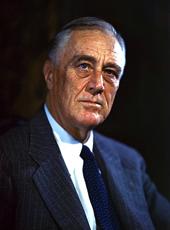We hear a good bit about differences between the United States and Britain, but perhaps we hear less of how really effectively they are working together in winning the war; and, also, in meeting the economic problems of the areas they liberate.
Together with Prime Ministers Churchill and Mackenzie King, I have just outlined the work the Combined Boards are to do from now until the end of the war with Japan. The Combined Food Board, the Combined Raw Materials Board, and the Combined Production and Resources Board provide a strikingly successful example of United Nations' collaboration on some of the urgent and difficult problems of the day.
The Boards are dealing now with serious shortages in such commodities as tires and trucks, coal, textiles, footwear, animal protein foods, and fats and oils. In each of these items the shortage is big enough to affect military requirements, civilian needs, and relief activities in all areas. In the case of the Combined Food Board, representatives of other countries also have participated in the development of appropriate international programs for certain commodities; e.g., Newfoundland fish and Australian wheat. There have also recently been added to certain commodity committees on the Combined Food Board representatives of countries whose supplies and requirements, through progress of military operations, have again become, or will become, important factors in the international distribution of vital supplies; e.g., France, Belgium, The Netherlands, and Norway in the case of fats and oils. The requirements of the Soviet Union have been related to the activities of the Boards through the Departments of the member Governments concerned with the conclusion of the annual protocols by which the Soviet Union supply programs are determined.
Through the Boards, former occupied countries are being helped to start up their manufacturing because we want to ease shortages of plants and manpower here, in Britain, and in Canada. We are acting with awareness, too, of the acute need to restore employment in the liberated areas, thus minimizing unrest.
Coal offers a good example of the working of the Combined Boards. It was clear at the beginning of 1943 that the United Nations as a whole faced a serious deficit. The Boards worked out solutions through the appropriate national agencies.
These solutions reached dramatic proportions. From Britain came expert opinion that production could be stepped up if surface outcroppings could be worked on a mass-production basis similar to our American strip mining. As a consequence, the used machinery market of the United States was scoured for such types of machinery—some machines, for instance, which had been in service along the Mississippi levees for twenty years were requisitioned—and a total quantity of machinery estimated to exceed in capacity that used in digging the Panama Canal was expedited to Britain during 1944.
Most of it has now arrived and in many parts of Britain the operations are under way with the result that 12 million additional tons are expected to be mined before the end of the present coal year. This coal helps supply S.H.A.E.F. needs in northwest Europe as well as those relief requirements for the Mediterranean that can be filled by our present limited transportation.
The Combined Food Board has proved to be a most useful mechanism for assuring an efficient and reasonably equitable distribution of vital food resources among the various United Nations. On the basis of detailed information interchanged constantly among its Commodity Committees, the Combined Food Board has developed many international plans for meeting the increased war demands and for offsetting, insofar as possible, the early loss to the enemy of important items. The shortage of rice after the fall of Burma and other areas of southeastern Asia is illustrative of the problems which have confronted the Combined Food Board. The Japanese occupation absorbed areas which normally export 95 percent of the rice entering world trade. The Board moved promptly to insure (1) that exports from the remaining rice areas were maximized, (2) that such supplies were equitably shared, and (3) that wherever possible, rice substitutes were provided.
The Boards have set a model for economic cooperation between the United Nations in overcoming excessive nationalism and in gaining cooperation between former rivals both on the national and international plane.
On the American side, the direction of the Raw Materials Board has been, since its inception, the job of William L. Batt. We owe him a deep debt of gratitude for his part in keeping an effective flow of strategic materials coming during the war, despite the fact that many of the former rich sources for these materials have been continuously in Axis hands. It has been a magnificent job.
Franklin D. Roosevelt, Statement on the Retention of Boards Until the End of the War. Online by Gerhard Peters and John T. Woolley, The American Presidency Project https://www.presidency.ucsb.edu/node/210117

